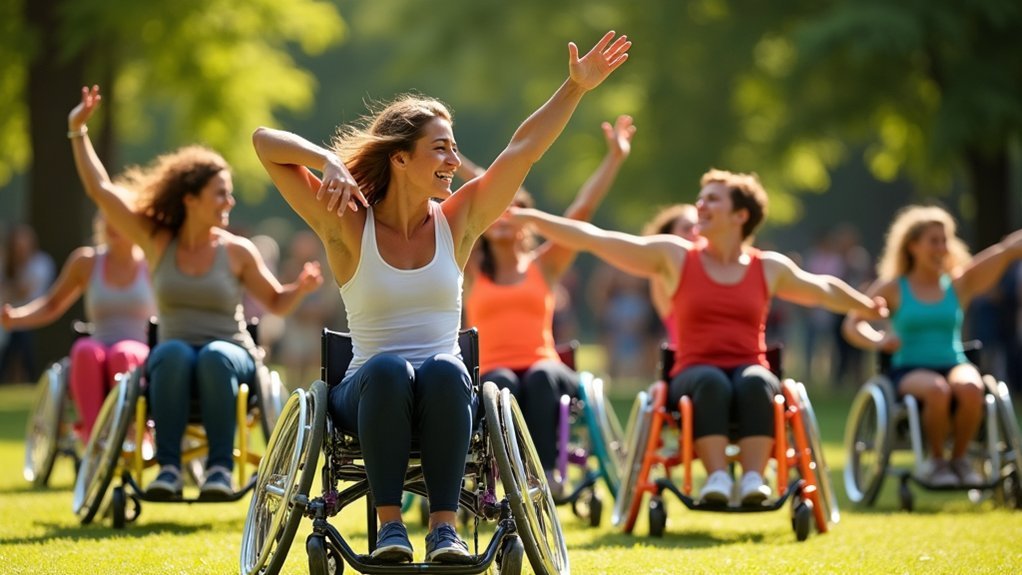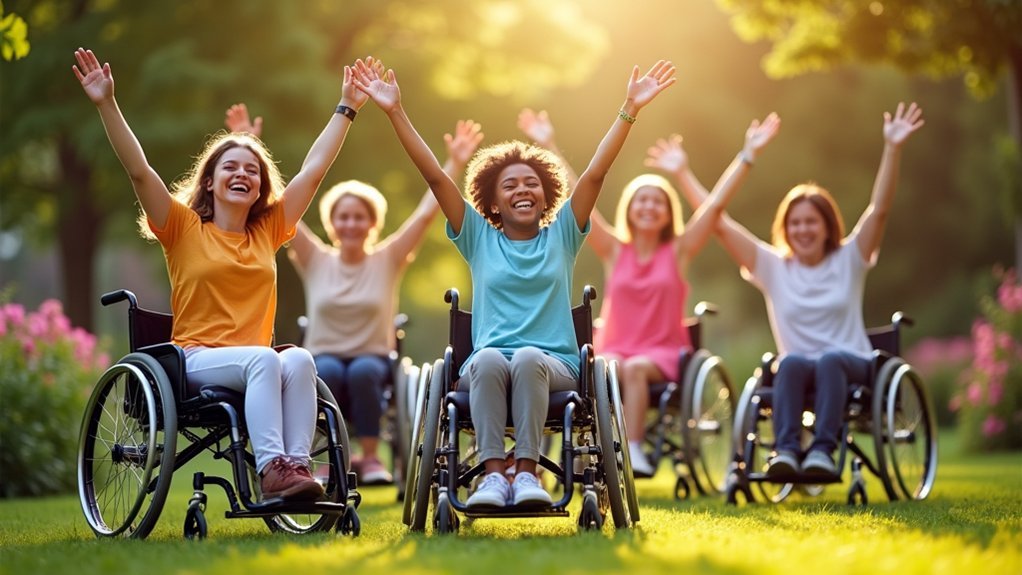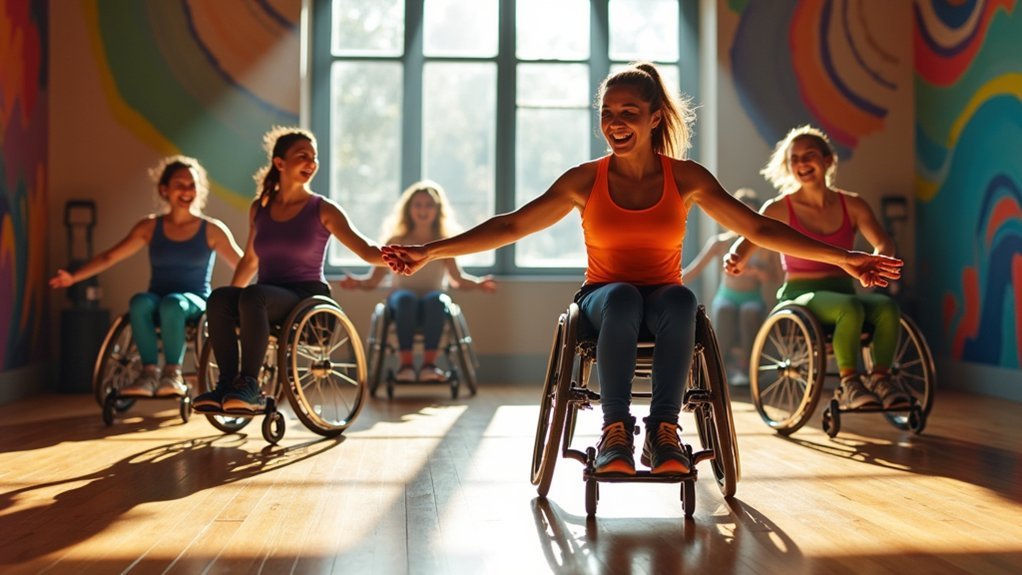Wheelchair dance fitness offers you a unique path to health and happiness through rhythmic movement. You’ll strengthen muscles, improve flexibility, and boost cardiovascular health while expressing yourself creatively. The social aspect connects you with a supportive community, building confidence and breaking isolation barriers. Whether you prefer ballroom, contemporary, or cultural styles, these accessible routines celebrate your abilities rather than limitations. Discover how transforming space into movement can revolutionize both body and spirit.
The Physical Benefits of Wheelchair Dance Movement

Five key physical improvements emerge when individuals participate in wheelchair dance fitness.
You’ll notice enhanced posture and mobility as you engage in various dance styles, directly addressing challenges you might face as an elderly individual with a disability.
Your cardiovascular health improves markedly through regular participation, promoting better circulation and overall fitness levels.
The dance movements strengthen your muscles and boost coordination as you execute arm movements and shifts between dance sequences.
Perhaps most importantly, you’ll experience improved flexibility and extended range of motion through rhythmic movements.
These benefits are essential for maintaining your independence in daily activities.
As you dance, your body adapts to new movement patterns, helping you build strength while enjoying the physical activity.
Building Community Through Rhythmic Expression
While physical improvements are significant, wheelchair dance fitness also serves as a powerful community builder, evident at Beijing’s Dongcheng Service Center where seniors with disabilities gather weekly to share in rhythmic expression. You’ll find a vibrant community atmosphere as over 70% of the center’s 37,000 members engage in these Tuesday sessions.
| Community Benefits | Personal Growth |
|---|---|
| Social connections | Increased confidence |
| Volunteer partnerships | Enhanced self-expression |
| Public performances | Fun time with peers |
When you join wheelchair dance, you’re not just exercising—you’re becoming part of something larger. Volunteers averaging 60 years old partner with participants, creating meaningful connections. The Chinese government’s commitment to accessible fitness sites further strengthens these bonds, allowing you to experience the joy of dancing while building lasting friendships.
Finding Your Dance Style: Options for Every Ability

Whether you’re new to wheelchair movement or a seasoned participant, discovering your unique dance expression begins with exploring the diverse styles available at centers like Dongcheng.
Every Tuesday, you can learn a little bit of everything—from classic Macarena moves to modern Beyoncé-inspired routines.
You’ll find wheelchair dance emphasizes arm choreography and rhythmic movement that lets you express yourself while seated.
Volunteers are always ready to assist as you try one last dramatic flourish or perfect that challenging sequence that’s got a little more complexity.
The beauty of wheelchair dance lies in its adaptability.
Whether you prefer expressive emotional performances or upbeat fitness routines, there’s a style that matches your abilities and helps build your confidence in a supportive community.
From Hesitation to Celebration: Overcoming Dance Barriers
Many first-time participants arrive at wheelchair dance classes with doubt clouding their faces, much like Dong Jingli did before discovering her passion for movement. You’ll find that emotional barriers often stem from years of feeling inadequate due to your disability.
The journey begins with improving your posture and mobility, helping you overcome physical limitations you’ve faced throughout life. With each practice, you’ll notice your confidence growing alongside your dance skills.
| Barrier | Challenge | Solution |
|---|---|---|
| Emotional | Feelings of inadequacy | Supportive environment |
| Physical | Limited mobility | Targeted training |
| Social | Isolation | Community engagement |
| Confidence | Fear of performance | Gradual exposure |
| Identity | Self-doubt | Celebrating abilities |
With community support and volunteer assistance, you’ll soon find yourself not just dancing, but thriving—eager to perform and celebrate your unique abilities through movement.
Music as Medicine: The Therapeutic Power of Dance

Healing resonates through the studio as wheelchair dancers connect with rhythm and melody.
You’ll witness how music transforms the atmosphere at Dongcheng Service Center, creating a therapeutic environment where participants find emotional release and connection.
When you observe wheelchair dancers moving to uplifting beats, you’re seeing music’s ability to serve as powerful medicine.
It’s not just about physical movement—the music creates a sense of belonging and community among dancers who’ve often faced isolation due to their disabilities.
You’ll notice how participants like Dong Jingli experience profound psychological transformations through this musical connection.
Their increased confidence and self-expression emerge naturally as they surrender to the rhythm, finding freedom in movement that transcends physical limitations and nurtures emotional well-being.
Partner Dancing: Creating Connection Through Movement
As wheelchair dancers join hands with able-bodied partners at the Dongcheng Service Center, a remarkable transformation unfolds in both physical ability and emotional wellbeing.
You’ll notice how these connections break down emotional barriers, replacing feelings of inadequacy with confidence as dancers express themselves through movement.
The collaborative nature of partner dancing improves your mobility and posture while fostering meaningful social interactions.
When you participate, you’re not just exercising—you’re building community.
During regular training sessions, you’ll experience the joy of dressing up for performances alongside fellow dancers who share your passion.
This inclusive environment encourages you to embrace your identity and seek audience engagement, completely transforming how you see yourself and your capabilities through the power of shared movement.
Dressing the Part: Fashion and Self-Expression in Wheelchair Dance
The transformation begins the moment wheelchair dancers choose their attire for performance day. You’ll notice how a carefully selected outfit can instantly boost your confidence, allowing you to fully embrace your identity on the dance floor.
When you dress stylishly for wheelchair dance events, you’re not just preparing for physical activity—you’re engaging in a form of self-expression that breaks emotional barriers. Your fashion choices showcase your personality while contributing to the festive atmosphere that makes these gatherings so special.
You’ll find that balancing comfort with creativity enhances your overall performance. As you coordinate outfits with dance partners, you’re also fostering community connections.
The right attire empowers you to feel more confident in your abilities, ultimately enhancing your entire dance experience.
Global Wheelchair Dance Communities and Competitions
From Beijing to Barcelona, wheelchair dance has evolved into an internationally recognized sport that connects individuals across continents through rhythm and movement.
You’ll find vibrant communities like Beijing’s Dongcheng Service Center hosting regular sessions for seniors with disabilities, fostering social engagement and inclusivity.
Major international competitions offer you opportunities to:
- Represent your country while forming friendships with dancers worldwide
- Showcase your unique style and self-expression on a global stage
- Experience how different cultures interpret and adapt wheelchair dance
With approximately 11,000 accessible fitness sites established in China alone by 2020, you’re part of a growing global movement.
These competitions don’t just celebrate athletic ability—they transform participants’ self-perception while promoting cross-cultural understanding through shared passion for dance.
Setting Up Your Home Dance Space for Accessibility
You’ll need to create a space-saving layout by arranging furniture against walls and utilizing foldable equipment that can be stored when not in use.
Consider essential accessibility items like non-slip flooring, mirrors placed at appropriate heights, and stable support bars that accommodate both seated and standing positions.
Your equipment checklist should prioritize adjustable lighting systems, portable speakers with clear sound quality, and wheelchair-friendly pathways that allow for unobstructed movement throughout your dance area.
Space-Saving Layout Options
Creating a functional dance space at home doesn’t require a massive studio—just five strategic decisions can transform even compact areas into accessible wheelchair dance zones.
Start with the essentials: a clear 5×5 foot area is your non-negotiable foundation, ensuring you can move freely without obstacles.
Invest in furniture that serves multiple purposes and can be easily repositioned. Place mirrors strategically on walls to create depth while providing visual feedback for your movements.
Remember that flooring matters—non-slip surfaces prevent accidents while dancing.
- Choose corner-mounted lighting fixtures that don’t intrude on your dance space while offering adjustable brightness
- Utilize folding or stackable chairs that can be quickly stored when you need more room
- Install wall-mounted storage solutions for dance props and equipment
Essential Equipment Checklist
With your space-saving layout established, the right equipment transforms your area into a complete wheelchair dance studio.
First, verify you’ve created sufficient clearance for a 5-foot turning radius, allowing smooth movement during your routines.
Invest in a quality adjustable chair with proper back support to maintain correct posture while dancing.
Your safety depends on stable flooring—consider non-slip dance mats that provide the perfect balance of grip and glide for wheelchair movements.
Enhance your dance experience with accessible aids like resistance bands or lightweight dumbbells to amplify arm routines and build upper body strength.
Finally, don’t underestimate the power of good sound—set up speakers that deliver clear, vibrant audio to keep you motivated and in rhythm during every session.
Frequently Asked Questions
How to Do the Wheelchair Dance?
Start with posture exercises, then master wheelchair mobility. Try fun moves like the Travolta or Macarena, focusing on arm movements. Express yourself with dramatic gestures, adding your own flair. Don’t forget to warm up first!
Does Dancing Count as Exercise?
Yes, dancing absolutely counts as exercise! You’re burning calories, building strength, and boosting cardiovascular health when you dance. It’s a full-body workout that improves flexibility, coordination, and endurance while being incredibly fun.
How Do People in Wheelchairs Stay Fit?
You can stay fit in a wheelchair through adaptive exercises like wheelchair dancing, swimming, seated strength training, and arm-cycling. These activities boost your cardiovascular health and strengthen your upper body muscles without standing.
Which Dance Is Best for Health?
For your health, any dance you’ll consistently enjoy is best. Ballroom improves posture, hip-hop builds strength, and waltz enhances cardio fitness. You’ll gain the most benefits from dances you’re motivated to continue.
In Summary
By embracing wheelchair dance fitness, you’ve discovered more than just a workout—you’ve found a pathway to joy, expression, and community. Don’t let hesitation hold you back. You’re part of a growing global movement that celebrates ability through movement. Whether dancing solo or with partners, you’re nurturing your body, mind, and spirit. Keep exploring new styles and spaces—your dance journey is uniquely yours to enjoy.





Leave a Reply